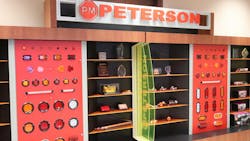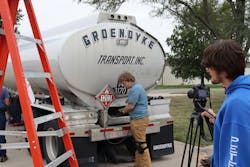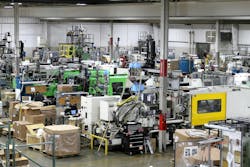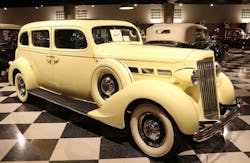Lighting the way: Peterson illuminates 80 years of innovation
GRANDVIEW, Missouri—Peterson Manufacturing turned 80 years old in 2025.
To mark the oak anniversary, the vertically integrated supplier of commercial vehicle lighting and wiring harnesses modernized its signature stop-sign logo to elevate brand awareness, redesigned its website to enhance functionality, refreshed its LED and incandescent print catalogs, and rolled out new products, including the “first-of-its-kind” repairable J560 connector.
Now it’s asking a group of third-party providers to help spread the word.
“You guys are the storytellers—and you do it well,” Missy Pinksaw, Peterson marketing director, told reporters gathered for a media open house Oct. 9 at the company’s 44-acre headquarters. “I really do believe this is the final piece of the puzzle for us. You guys are the connectors in the industry. You keep us connected, you highlight new innovations, and you tell your readers—who are our customers—what matters. So how you tell our story is important.”
The event, which coincided with National Tank Truck Carriers’ 2025 Tank Truck Week in Kansas City, Missouri, included presentations on Peterson’s American-made history and unique manufacturing capabilities; a tour of the family-owned company’s highly automated lighting and harness facilities, and its Mission Plastics North and Vector Tool and Engineering operations; and an exclusive look at the Armacosts’ compelling collection of classic cars.
Several members of Peterson’s experienced executive team, including Vice President of Sales and Marketing Al Anderson, Senior Manufacturing Manager Jake Chambers, Product Manager Bill Cook, Director of OEM Sales Jay Davenport, Senior Manager of Fleet Sales Dan Miller, and VP of Operations Jim Rash, set the stage for attendees, providing industry insights, behind-the-scenes production details, and a sneak peek of innovative new offerings still to come.
“We’re proud of our heritage and what you’re going to see,” Anderson said.
The Peterson difference
Wilbur Peterson founded Peterson Manufacturing in 1945 in nearby Kansas City. The company’s first customer was Western Auto, whose iconic sign still sits atop the original downtown building, about 18 miles north of Grandview. The first product was a bike pump, an example of which was displayed in Peterson’s main conference room when Bulk Transporter visited.
Local businessman Don Armacost Sr. purchased Peterson in 1956, beginning the Armacosts’ 69-year stewardship. He served as CEO and chairman before retiring; and now his sons, Don Armacost Jr. and David Armacost, lead the company, Don Jr. as chairman and David as president and CEO. Today, the quarter-billion-dollar, multi-faceted corporation supplies premium side and rear safety lighting and wiring solutions globally across a range of commercial vehicle markets, including heavy-duty and tank trailers; light- and medium-duty trailers and straight trucks; intermodal chassis trailers; and work and utility trucks.
See also: Peterson launches repairable J560 connector
Peterson’s vast product portfolio includes 2,500 unique lighting SKUs and 6,200 wiring harness SKUs.
“The wiring harnesses are very unique,” Anderson said. “Every trailer manufacturer and every fleet has its own unique way of lighting things up—and we must accommodate all of those things.”
Vertical integration across the lighting and wiring supply chain is the key to Peterson’s lasting success, Anderson added. Vector makes plastic injection molds, tools, and fixtures, and designs and builds much of Peterson’s automation; and Mission produces the plastic parts that go into Peterson’s products. The group also makes its circuit boards, tests devices for FMVSS 108 compliance in its certified metrology lab, and checks reliability in its environmental lab. “Vertical integration is so important to the way we do things—the speed with which we can bring things to market, and the flexibility in our manufacturing,” Anderson explained.
Integration and process innovation also lower production costs—and keep Peterson’s pricing competitive.
“We have not had any adjustments in our price sheets since Jan. 1, 2023,” Anderson noted. “In the face of inflation, and all the uncertainty, we’ve held the line [for almost three years]. Now, we are going to have a price adjustment … on Jan. 1, 2026, but about 97% [of our prices] are going to stay the same or go down—and some will go down dramatically.
“That’s a testament to our factory, and the innovation engineering puts together.”
History of innovation
Trademark innovations include Peterson’s Defender and PetersonPatriot lighting systems, and PetersonPulse smart trailer system. The company also released a 506K LED Heated Snow Plow Light Kit and launched the repairable J560 seven-way connector in the last three months.
Defender and PetersonPatriot, Defender’s “little brother,” both feature LED diodes and corrosion-resistant construction that protects electrical systems from deicing road chemicals. The highly customizable Defender boasts “billions of miles” with “virtually zero” corrosion issues, Anderson said. “Corrosion is, without a doubt, the No. 1 cause of problems in the commercial vehicle industry today,” he emphasized. Other product options include programmable and turn-signal override strobes, on/off switches for interior trailer lights, and a variety of other lighting features.
PetersonPulse, which debuted in 2018, is Peterson’s still-evolving CAN bus-based intelligent trailer controller that monitors vital systems in real time, delivers alerts to drivers and fleet managers via Bluetooth and telematics-enabled communications, and unlocks unique capabilities like pinpoint light-out detection. The system first took off with refrigerated fleets and now is growing in popularity with bulk haulers, Anderson said—a point underscored by the installation of a PetersonPulse system on a Groendyke tank trailer during the open house (look for more on that in the upcoming issue of Bulk Transporter magazine).
“Everybody’s now starting to see the advantages of really being connected to their equipment,” Anderson said.
See also: Peterson celebrates 75th anniversary
Manufacturing innovations include longer-lasting fiberglass circuit boards, surface-mounted LEDs with optimized heat dissipation, and molded terminals that provide an elite moisture seal.
“We’re the only people in the industry who mold completely around the terminals on the base of the lamp housing, eliminating the possibility of moisture intrusion at that point,” Davenport said.
Vertically integrated operations
Peterson’s Grandview campus includes four factories that total 675,000 sq. ft. of production space, all connected by enclosed walkways, or “tunnels” as they’re called internally, that keep employees out of the elements year-round. Along with one other Mission location in Nashville, Arkansas, Peterson’s manufacturing capabilities leverage proprietary automation—much of it built in-house—that boost scale and volume to “reduce labor costs considerably,” Rash said.
The tour, led by Chambers, started in the harness facility, then took guests through the Vector and Mission facilities before ending in the lighting plant. “We pride ourselves on having a single factory that can do everything right here,” Anderson said.
The wiring harness operation includes its own engineering and customer service teams, and most manufacturing runs are in small, customized batches, Chambers said. The first stop highlighted the injection molding machines that mold around Peterson’s myriad pigtails and harness extensions—including amp-style connectors—allowing it to offer the industry’s only 10-year corrosion warranty. All Defender harnesses are seal-tested in a fresh-water station using pressurized air.
Chambers also pointed out Peterson’s unique harness manufacturing techniques, including pulse injection molding and ultrasonic welding, which uses high-frequency vibrations to splice copper wires.
Vector, where Chambers spent the first 16 years of his Peterson career, serves internal and external customers, who make up about 50% of its business. Chambers spotlighted the operation’s horizontal and vertical mills, and five-axis lathe; and explained how Vector utilizes electrical-discharge machining to erode and shape electrically conductive materials with high precision—an “invaluable process in the mold-building industry,” Chambers maintained.
“East Trailers asked us to make a smaller mold to run through their rails,” he said. “Any other manufacturer would have needed six to 12 weeks to do that. We had the molds ready in two weeks.
“That’s the advantage of having an internal tool and engineering shop like this.”
Mission, which also serves outside customers, runs three shifts, while the other three facilities each run two shifts. Injection molding requires careful setup of time, temperature, and materials; and every parts recipe is recorded in hard-copy form and stored in an expansive library. Guests watched robots mold terminals into product housings; and learned the facility’s utilities are hidden in a lower level, making the factory floor safer for employees.
Before heading to the lighting facility, attendees stopped in the metrology lab, where Peterson performs first-part inspections and ensures lights conform to regulations—typically up to 25% brighter than required by FMVSS 108—in a blacked-out, 100-ft.-long photometric tunnel.
The final stop showcased Peterson’s robot-assisted flexibility, which allows it to manufacture lights in high- and low-volume runs as needed; circuit-board production, which takes place in a temperature-controlled, static electricity-proof room; and environmental lab, in which Peterson monitors durability using a Tenney environmental tester, vibration tester, and run-time test board—where some parts have been running for more than 20 years.
“Our engineering team is constantly looking at different ways to do things—and not necessarily cheaper,” Anderson concluded. “We don’t do cheaper. We innovate. As Don Jr. says, we’re the best at what we do.
“It’s about making things more reliable and durable, and, at the same time, using more cost-effective technology.”
About the Author
Jason McDaniel
Jason McDaniel, based in the Houston TX area, has more than 20 years of experience as an award-winning journalist. He spent 15 writing and editing for daily newspapers, including the Houston Chronicle, and began covering the commercial vehicle industry in 2018. He was named editor of Bulk Transporter and Refrigerated Transporter magazines in July 2020.




